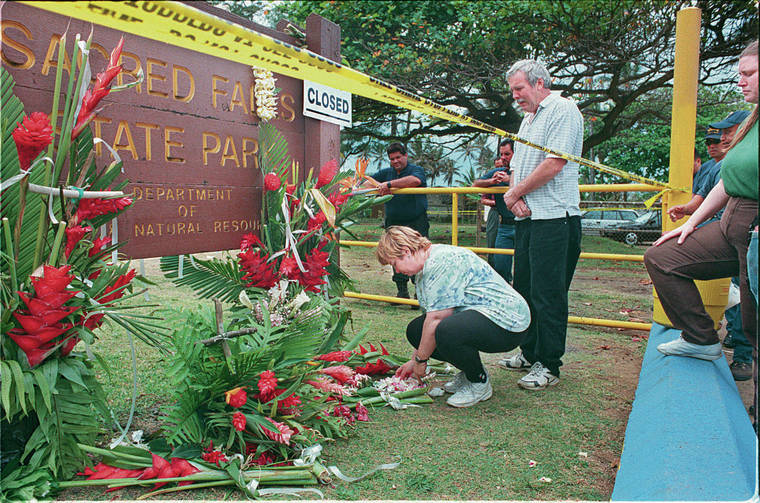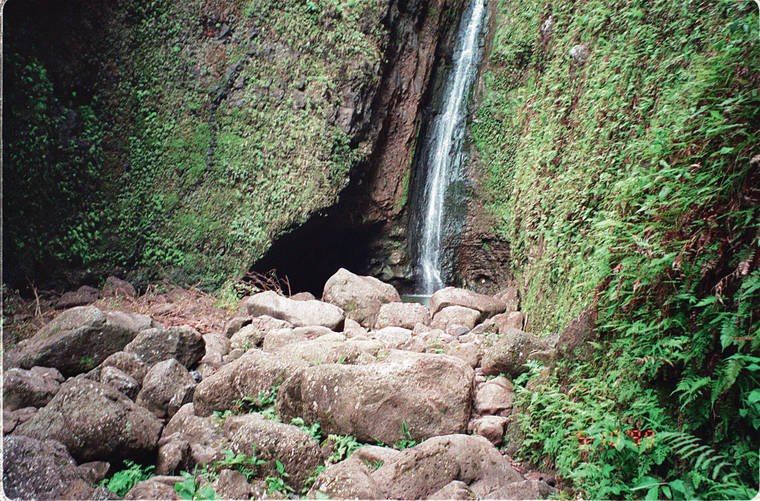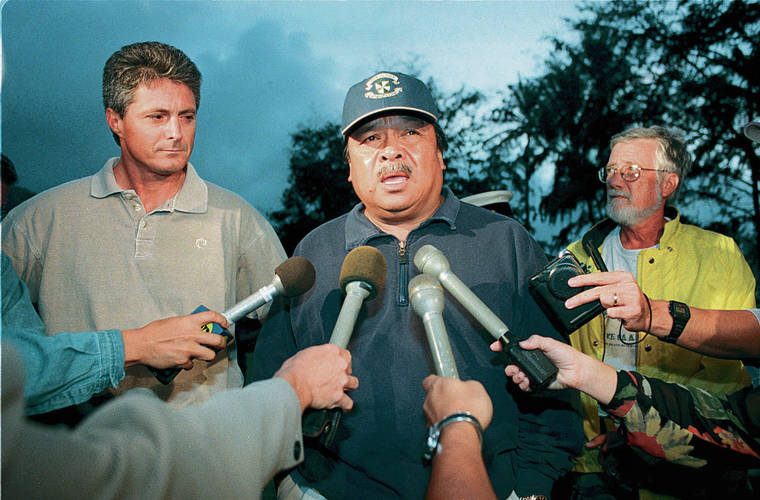It was 20 years ago today — on a picture perfect Mother’s Day — when boulders rained down from 50 feet above Sacred Falls State Park with the sound of a freight train, killing eight people and injuring about 50 more.
The 1,376-acre park below the Koolau Mountains never reopened and the park entrance remains locked, surrounded by dozens of warning signs.
In 2003 the state paid $8.56 million in damages to injured survivors and to the families of the dead. And yet, people continue to trespass in to get a glimpse of the Sacred Falls waterfall known to Hawaiians as Kaliuwa‘a.
Today, someone who is injured or killed while trespassing into Sacred Falls State Park likely will receive no sympathy before a court, said Honolulu attorney Larry Remillard Jr.
Remillard and attorney Arthur Park represented the families of four people who were killed and 19 others who were injured who received the $8.56 million settlement. All of them were tourists or military personnel stationed on Oahu.
“If they (hikers) go out there now, the likelihood that they could assert any viable claim against the state is understandably nil,” Remillard said. “People like to do fun and exciting things and, particularly in our present age of social media, they’re not always exercising good judgment.”
The tragedy prompted legislators to create a statewide warning signage system designed to protect state and county governments from liability on certain parks and trails.
But state Department of Land and Natural Resource Division of Conservation and Resources Enforcement agents continue to chase down people trespassing into Sacred Falls.
In 2014 alone, DOCARE agents issued more than 120 trespassing citations, primarily to military personnel and tourists, according to DLNR.
So far this year, they have issued at least 11 citations at Sacred Falls, according to DLNR spokesman Dan Dennison.
The penalties are $100 for a first violation, $200 for a second and $500 for a third offense.
The Board of Land and Natural Resources also can pursue civil penalties of $2,500 for a first violation, $5,000 for a second and $10,000 for a third violation, according to DLNR.
At the urging of state officials, DLNR said multiple travel websites removed directions to Sacred Falls State Park and instead provided links to a video called “Sacred Falls-Don’t Risk Your Life, a Fine, or Jail” that DLNR created in 2015.
The six-minute video can be found at vimeo.com/119992399. It’s been scanned 657 times at Sacred Falls and viewed 17,900 times across social media platforms, Dennison said.
Remillard said the victims’ settlements were paid out proportionately to their injuries.
Some child survivors had structured settlements and annuities set up for them for expenses such as college educations. One girl who lost most of her foot went on to play college basketball, Remillard said.
Another survivor, Mike Forsch of California, suffered a skull fracture and brain damage and never returned to his career as a pharmaceuticals salesman, Remillard said.
His wife, Donna Kim, “had both legs amputated and died at the scene, but not before telling first responders to tell her husband that she loved him,” Remillard said.
They were celebrating their 10th wedding anniversary when the rocks began falling.
For former Gov. Ben Cayetano, the Sacred Falls tragedy may have been the worst during his time in office, which also included the 1995 deaths of Honolulu Police Department Specialized Services Division officers Bryant B. Bayne and Tate Kahakai and Honolulu Fire Department helicopter pilot Peter Crown in the hills above Sacred Falls.
Kahakai and Bayne were dangling in a basket 50 feet below Crown’s Hughes 500D helicopter as it flew into rough winds and heavy cloud cover on the fifth day of the search for Wade Johnson, a 23-year-old Brigham Young University-Hawaii student who became lost while hiking. Johnson was never found.
Then in 2001, four Japanese high school students, two of their teachers and three crew members aboard the Ehime Maru Japanese fishing training vessel were killed when they were struck from below by the USS Greeneville fast attack submarine in waters off of Diamond Head.
The Greeneville was performing a maneuver called an “emergency ballast blow” that launched the sub toward the surface while VIPs were at some of the Greeneville’s controls.
But Cayetano believes that future tragedies at Sacred Falls State Park can be prevented if hikers just follow common sense and heed posted warning signs.
“There are risks to hiking and sightseeing and the government has an obligation to warn them,” Cayetano said. “If they still do it, it shouldn’t be the fault of the government. It is a tragedy that can be avoided.”






